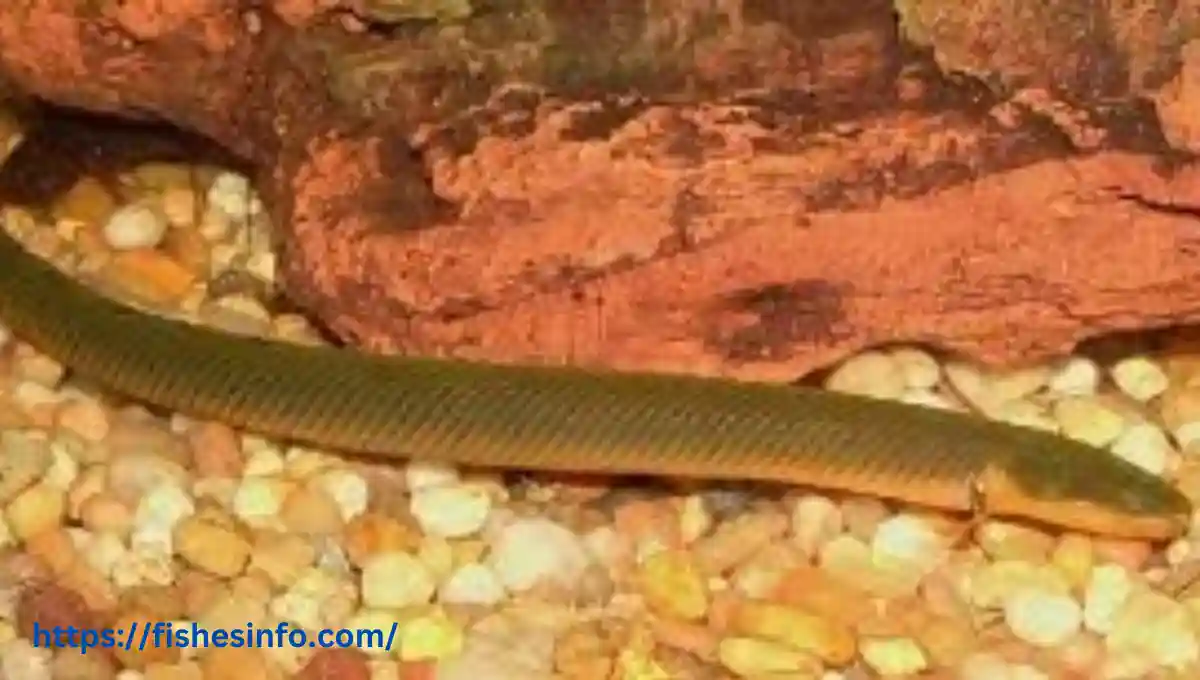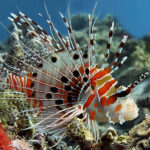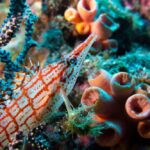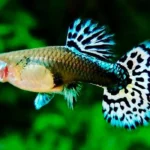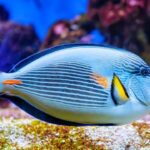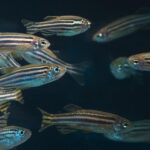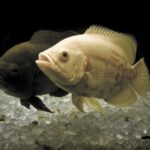Erpetoichthys calabaricus, often known as the ropefish or snakefish in the United States, is a kind of fish in the Polypteridae family, which also includes bichirs. Within the genus Erpetoichthys, it is the sole member. It is indigenous to West and Central African fresh and brackish seas.
The reedfish can withstand extremely low oxygen levels in the water because it has two sets of lungs along with its gills. Urbanization, deforestation, plantations that produce palm oil, and other forms of agriculture are threatening its habitat.
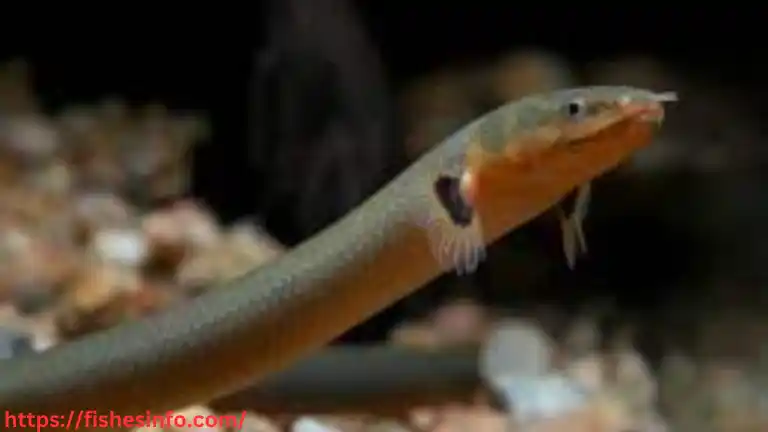
Reed Fish Habitat
The reedfish lives in fresh or brackish, slowly moving or standing relatively warm tropical water; it also usually lives in areas with a dense growth of reeds or other plants. It is found in the region between the Ouémé and Sanaga rivers in Benin, Cameroon, and Nigeria. Older and dubious data exist from the Chiloango River in the Democratic Republic of the Congo and Cabinda in Angola.
The genus is found throughout West Africa. The Niger River Delta is where anglerfish are most frequently seen, although its habitat extends from Benin to Cameroon. Although brackish water basins are also home to it, freshwater lakes and rivers are its preferred habitat.
Generally speaking, predator fish are most active at dusk and night. This one mostly eats insects and worms, although it also consumes small mammals. The African rope fish uses its sense of smell to find food because it has rather weak vision. Erpetoichthys calabaricus inhabits the muddy/silty waters of Africa, where visibility is limited because of the murky water.
Reed Fish Diet
Since rope fish are carnivores, meaty meals must be a regular part of their diet. This will guarantee that they receive enough nutrients and protein (along with enrichment).
Bloodworms, chopped flesh, frozen meat-based meals, insect larvae, and beef hearts are a few of the greatest things to feed them. The longest-living rope fish owners typically feed them a meaty diet, however, other owners will supplement with flakes and pellets.
You may occasionally choose to supplement their diet with some live food. We enjoy occasionally engaging in this for enrichment. Although it may not be the most practical choice for you as the owner, your fish will value it.
We recommend feeding rope fish once a day, shortly before you fall asleep because they are nocturnal. While some fish keepers have trained their fish to eat during the day, we prefer to maintain the fish’s natural feeding schedule.
For the general health and well-being of reed fish, commonly referred to as ropefish or snakefish, nutrition is a crucial factor. To provide the fish with the right nourishment and guarantee their longevity in captivity, it is essential to comprehend their dietary needs.
Because they are mostly carnivorous, reed fish eat mostly frozen or live food. Small invertebrates including insects, worms, and crabs are their preferred food. These can be supplied as frozen substitutes that are easily found in pet stores, or as live prey.
Rope fish exhibit a peculiar feeding strategy in which they would sooner ambush their prey than aggressively pursue it. To make it easier for the the fish to find and eat the food, it is advised to provide items that sink slowly or remain close to the bottom of the tank.
It is advisable to include premium pellets or flakes made especially for carnivorous fish in their diet in addition to live or frozen items. These commercial meals frequently include vital vitamins and nutrients that are needed for the general well-being of snake fish.
Providing reed fish with a diverse range of food alternatives is essential to ensuring that their diet remains balanced. This encourages healthy growth and development and aids in the prevention of dietary deficits. If the fish are eating enough food, it can be ascertained by regularly observing their feeding habits.
All things considered, knowing the particular nutritional requirements of reed fish is essential to maintaining their health and encouraging their native activities in captivity. Providing a wide variety of frozen or live foods in addition to premium commercial diets can help maintain the health and well-being of these amazing animals.
Reed fish Lifespan
One fascinating feature of reed fish biology is their lifetime. Knowing how long their life cycle is can provide important information about their behaviour, ways of reproducing, and ecological relevance as a whole.
Reed fish are members of the Erpetoichthyidae family, which is often referred to as ropefish or snakefish. These unusual freshwater species are indigenous to different parts of Africa. In general, snake fish have a longer lifespan than other freshwater fish, though there might be some differences between species and individuals.
According to studies, reed fish in captivity can survive for eight to ten years on average. Nonetheless, under ideal circumstances, tales of people living up to 15 years or longer have been made. It is noteworthy that various factors, including habitat quality, nutrition, water parameters, and general care, can have a substantial impact on the lifetime of these intriguing animals.
Rope fish require a lot of attention and dedication from aquarists because of their very long lifespan in comparison to many other aquarium fish species. Enrichment activities, a balanced diet, proper water conditions, and the right tank size can all improve their general health and possibly lengthen their lives.
Reed Fish Size
Reedfishes, which are approximately 30 cm (11.8 inches) in length as adults, have been measured to reach lengths as long as 37 cm (14.6 inches). The average snake fish, reaching over two feet in length, requires ample space to stay comfortable and make a stunning sight while swimming, as detailed in the following section.
Rope fish, with a long, smooth body, can grow up to 20 inches in the wild and 37 cm in a tank, although some can exceed 20 inches under optimal conditions.
African Rope Fish Size
The African rope fish, sometimes known as the reed fish, may grow to a length of between 12 to 20 inches (30 to 50 cm) in captivity. However, in the wild, they may grow somewhat bigger, reaching lengths of up to 24 inches (60 cm) or more.
Reed Fish Tank Size
Rope fish, which can grow up to 20 inches, require a spacious Aquarium to accommodate their size and provide a comfortable environment. A recommended tank size for a single adult snakefish is around 75 gallons (284 litres).
However, larger tanks provide more swimming space and a more natural environment with hiding spots. If you plan to keep multiple rope fish or have other tank mates, increase the tank size accordingly.
Rope fish are generally peaceful but can be predatory, so choose compatible tank mates and provide enough space to reduce aggression. In summary, consider a tank size of at least 75 gallons for a single adult fish and larger for multiple or other fish.
Rope Fish Tank Size Recommendations
- Minimum tank size: 50 gallons for one fish.
- For multiple fish, add 10-15 gallons for each.
- Ensure each fish has their own space and avoids interference.
Rope Fish Tank Mates
Rope fish, also known as reedfish or snakefish, are typically placid and may be housed with a variety of tankmates that are suitable for their size and disposition. Here are some potential tankmates for rope fish:
- Large, friendly fish: This fish may survive with larger, peaceful fish such as angelfish, gouramis, and larger tetras.
- Bottom dwellers: Since rope fish are typically bottom dwellers, they may be maintained alongside other bottom-dwelling fish like corydoras catfish and loaches.
- Non-aggressive mid-level swimmers: Fish that swim in the centre of the tank and are not aggressive, such as most tetras and rasboras, may also be ideal tankmates.
- Avoid aggressive or fin-nipping fish: It’s better to avoid keeping rope fish alongside aggressive or fin-nipping fish since snake fish have sensitive fins that may be harmed.
- Similar-sized fish: While rope fish are peaceful, they may devour smaller fish that can fit in their teeth. Therefore, it’s better to keep them among fish that are comparable in size or bigger.
- Compatibility with other rope fish: Rope fish are gregarious and may be maintained in groups of three or more, as long as the tank is big enough to support them.
When picking tankmates for your snake fish, it’s crucial to consider the size of your tank, since this fish wants lots of area to swim and explore. Additionally, check the behaviour of your tankmates to ensure they are not pestering or stressing your rope fish.
Water Parameter for Reed Fish
Temperature: 75°F to 82°F (24°C to 28°C)
Rope fish prefer somewhat warmer water temperatures within this range. Use a quality aquarium heater to keep a constant temperature.
pH Level: 6.5 to 7.5
Snake fish thrive in slightly acidic to neutral pH levels. Regularly test the water pH and make changes if required using pH stabilizers.
Water Hardness: Soft to moderately hard (4 to 15 dGH)
The fish can endure a variety of water hardness levels, although they normally perform well in slightly soft to moderately hard water.
Ammonia and Nitrite: 0 ppm (parts per million)
Ammonia and nitrite are poisonous to fish, particularly snake fish. Make sure these levels stay undetected by utilizing sufficient filtration and frequent water changes.
Nitrate: Below 40 ppm (ideally lower)
While rope fish are fairly tolerant to nitrates, it’s recommended to maintain them at lower levels. Regular water changes will help keep nitrate levels in control.
Dissolved Oxygen: Adequate oxygen levels
Aeration is not essential for a rope fish. Due to its anatomical organization properties, it can swallow ambient air and extract oxygen from it. This procedure is simple to observe – from time to time a fish comes to the water surface takes some air with its mouth and returns to the tank bottom after that. The snake fish requires unrestricted access to the tank surface, or else it’ll die from asphyxia because merely gill breathing is not enough for it. In general, this fish is a traditional example of bottom dwellers.
Filtration: Efficient filtration is needed to preserve water quality.
Use an appropriate filter that can accommodate the tank size and biological load. Since this is a predator, it leaves a lot of organic waste, hence a canister filter is essential.
Remember to periodically test the water parameters using proper test kits and execute partial water changes (approximately 20-25% of the tank capacity) every week to maintain the water quality excellent for your rope fish. Keeping a steady and clean environment will help the health and lifespan of your aquatic pets.
Reed or Rope Fishing Rods
A fishing rod that is both long and flexible enough to manoeuvre through the reeds without becoming tangled is ideal for fishing. This fishing often makes use of the following fishing rod types:
- Fishing Rods with a Telescopic Shaft: The versatility and portability of telescopic rods make them an ideal tool for accessing reeds. Plus, they’re not hard to steer in confined areas.
- Fishing Rods Made of Whips: Because of their length and pliability, whip rods are ideal for accurate casting in confined spaces. They work well for reed fishing and are often used in pole fishing.
- Fishing Rods That Float: Reed fishing, particularly in shallow areas where accurate casting is crucial, may be facilitated by using a float rod, which is specifically intended to cast a bobber or float.
- Spinning Rods: Spinning rods are flexible and may be used for numerous fishing strategies. Look for a longer spinning rod for fishing, since it will provide you more reach and control.
- Match Fishing Rods: Match rods are long and flexible, great for reaching over reeds and making precise throws. They are often employed in coarse fishing, notably reed fishing.
When purchasing a fishing rod for rope fishing, examine the length, flexibility, and casting capabilities of the rod to ensure it fulfils your requirements in reed-covered locations.
Frequently Asked Questions (FAQ)
Can Dwarf Gourami live with Reedfish?
Yes, Dwarf Gouramis may often coexist alongside Reedfish (also known as Ropefish or Reedfish). However, there are a few issues to bear in mind:
Tank Size: Both Dwarf Gouramis and Ropefish need appropriate room. A bigger tank (at least 30 gallons or more) with lots of hiding nooks and a swimming room is suggested.
Temperament: Dwarf Gouramis are normally docile, although they may be possessive, particularly after breeding. Ensure that there are lots of hiding locations and visible obstacles to decrease aggressiveness.
Water conditions: Both species demand comparable water conditions. Keep the water temperature between 75-82°F (24-28°C) and keep a pH level between 6.5-7.5.
Tank Mates: Consider the compatibility of other tank mates as well. Avoid aggressive or fin-nipping fish that may bother the Reedfish or Dwarf Gouramis.
Feeding: Both species are omnivores. Ensure they get a diverse diet fit for their requirements.
It’s usually a good idea to observe the behaviour of all tank mates and be prepared to separate them if any hostility happens.
Is Reedfish an eel?
No, Reedfish, often known as Ropefish or Snakefish, is not an eel. whereas they have a similar look with their long, thin bodies and absence of pelvic fins, Snakefish belong to the Bichir family (Polypteridae), whereas eels belong to the Anguilliformes order. These are freshwater fish found in Africa, and they have remarkable qualities including the capacity to breathe air and walk on land for short distances using their pectoral fins.
What does Reedfish eat?
Reedfish are carnivorous and generally consume live or frozen meals such as bloodworms, brine shrimp, earthworms, and tiny fish. They may also eat high-quality sinking pellets or flakes, although live or frozen feeds are preferable. Providing a variety of diets can help keep them healthy and active.
Would a peacock eel get along with a Reedfish?
Peacock eels and Reedfish have similar care requirements and generally get along well in a large enough aquarium with plenty of hiding spots. However, there’s always a risk of aggression, especially during feeding time or if the tank is too small. It’s important to monitor their behaviour closely and be prepared to separate them if any aggression occurs.
Are Rope Fish aggressive?
Snake fish are generally peaceful and not aggressive towards other fish. However, they may eat smaller tankmates that can fit in their mouth. It’s recommended to keep them with fish of similar size or larger to avoid any issues.
Will Rope Fish eat Guppies?
Yes, rope fish are known to consume tiny fish like guppies if they can fit them in their mouth. It’s not advisable to keep them together in the same tank.
How long a rope fish can live out of water?
Rope fish, also known as reed fish, evolved to breathe air and may live for brief durations out of water. They have a unique swim bladder that behaves like a lung, enabling them to collect oxygen from the air. However, they still need to be maintained wet and should not be left out of water for lengthy periods. It’s crucial to handle them with care and restore them to water as soon as possible.
Will Rope Fish Eat Neon Tetras?
Rope fish are normally placid and not aggressive towards smaller fish like Neon Tetras. However, there is a potential that they may regard the Neon Tetras as food, particularly if the Tetras are extremely tiny and fit inside the Rope fish’s mouth. It’s advisable to maintain them in a tank with fish of similar size to minimize any possible complications.
Can Reed fish eat shrimp pellets?
Yes, It can consume shrimp pellets. Shrimp pellets are a typical feeding option for reed fish and may be a component of their balanced diet. It’s crucial to ensure that the pellets are tiny enough for the reed fish to ingest comfortably. Additionally, supplying a variety of items, such as live or frozen foods, may assist give a well-rounded diet.
Can reed fish live with Khuli Loaches?
Yes, the fish can often survive with kuhli loaches. Both species are docile and require comparable tank conditions, making them suitable tank mates. However, it’s crucial to observe their behaviour and ensure that both species have ample room and hiding locations to avoid any possible disputes.
Do Reed Fish eat Snails?
Yes, It may consume little snails, particularly if they can fit them into their jaws. However, they are not often regarded as enthusiastic snail-eaters like some other fish species.
Conclusion
In conclusion, rope fish are intriguing and distinctive additions to a freshwater aquarium. They are quiet, simple to care for, and can cohabit with a variety of tankmates. Their eel-like look and behaviour make them an interesting animal to study.
However, it’s vital to supply them with a proper habitat, including lots of hiding spaces and a well-maintained tank. With appropriate care, rope fish may survive for many years and become a wonderful component of your aquatic society.
